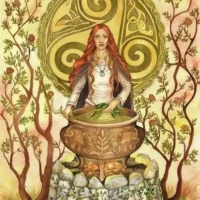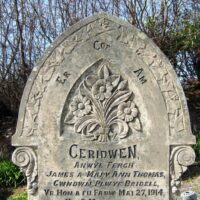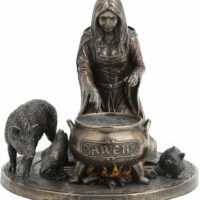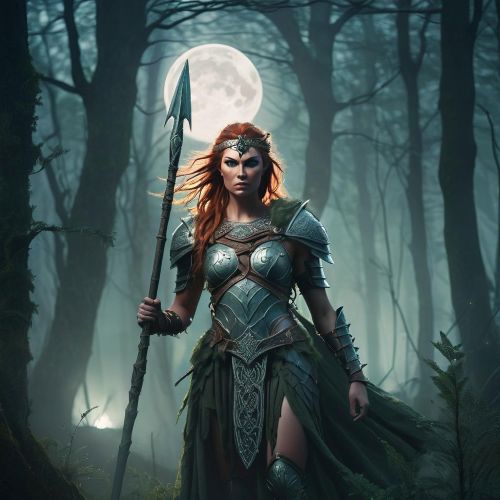Ceridwen : Goddess of Rebirth
Listen
At a glance
| Description | |
|---|---|
| Origin | Welsh Mythology |
| Classification | Gods |
| Family Members | Tegid Foel (Husband), Creirwy, Morfran (Children) |
| Region | Wales |
| Associated With | Magic, Shapeshiftng, Beauty, Rebirth, Transformation |
Ceridwen
Introduction
Ceridwen, a key figure in Welsh mythology, is revered as an enchantress and goddess linked to wisdom, transformation, and prophecy. Keeper of the mystical cauldron, she symbolizes the cycles of life, death, and rebirth. Her tale, preserved in the 14th-century manuscript Hanes Taliesin, explores her quest for knowledge and her role in shaping the destiny of the bard Taliesin. Rich in symbolism, her legend remains an enduring part of Celtic tradition.
Physical Traits
Ceridwen is a shape-shifting goddess whose changing forms reflect her mastery over transformation. Depending on the tale, she appears as a nurturing mother, a wise crone, or even a white sow, symbolizing fertility and intuition. Rather than having a fixed appearance, she embodies the fluid nature of wisdom and the cycles of life. Often linked to the moon and the Underworld, her presence carries an air of mystery, blending beauty, power, and the dual forces of creation and destruction.
Family
Ceridwen was the wife of Tegid Foel, a nobleman who resided near Bala Lake (Llyn Tegid) in North Wales. Their daughter, Creirwy, was renowned for her beauty, while their son, Morfran (Afagddu), was marked by his unfortunate appearance. Determined to grant Morfran wisdom and inspiration, Ceridwen crafted a powerful potion, unaware that fate had other plans. In a twist of destiny, the potion’s magic instead led to the birth of Taliesin, the legendary bard, further cementing her legacy as a goddess of transformation and knowledge.
Other names
Ceridwen’s name appears in various forms, including Cerridwen, Caridwen, and Kerridwen, reflecting linguistic shifts in Welsh tradition. Her name is often broken down into “Cerd,” which can mean poetry or song, and “Wen,” which signifies fairness, blessing, or purity. These interpretations reinforce her role as a goddess of inspiration and transformation. She is also known by titles such as The White Lady of Inspiration, The Keeper of the Cauldron, and The Great Mother, each emphasizing different aspects of her wisdom, magic, and nurturing power.
Powers and Abilities
Ceridwen is renowned for her mastery of magic, particularly transformation and rebirth. Her most iconic ability is brewing the potion of Awen in her enchanted cauldron, granting divine wisdom and poetic inspiration. Intended for her son Morfran, the potion is accidentally consumed by Gwion Bach, who gains immense knowledge and later becomes the bard Taliesin.
Her shape-shifting powers are displayed in her relentless pursuit of Gwion, as they engage in a dramatic chase, morphing into various creatures and elements. Beyond transformation, Ceridwen is linked to prophecy, herbalism, and the mystical forces of life, death, and renewal, reinforcing her role as a powerful and enigmatic figure in Welsh mythology.
Modern Day Influence
Ceridwen remains a powerful symbol in modern paganism, witchcraft, and creative expression. Revered as a goddess of wisdom, transformation, and inspiration, she is honored in Neopagan and Wiccan traditions, where her cauldron of Awen represents creativity and spiritual enlightenment. Many practitioners seek her guidance for personal growth and magical workings.
Her influence extends beyond spirituality into literature, music, and visual art, where she is often depicted as a force of feminine power and renewal. References to her myth appear in books, films, and television, reinforcing her status as a timeless figure in magical and mystical storytelling. Kristoffer Hughes’ Cerridwen: Celtic Goddess of Inspiration provides a deep exploration of her role in Welsh mythology and her continued relevance today.
Related Images
Source
“The Mabinogion” translated by Sioned Davies (Oxford University Press, 2007)
“Celtic Myth and Legend” by Charles Squire (Gramercy Books, 1997)
“The Encyclopedia of Celtic Mythology and Folklore” by Patricia Monaghan (Facts on File, 2004)
“The Book of Taliesin” edited by John Matthews (HarperCollins, 1997)
“The White Goddess” by Robert Graves (Farrar, Straus and Giroux, 1966)
Websites:
Frequently Asked Questions
What is lorem Ipsum?
I am text block. Click edit button to change this text. Lorem ipsum dolor sit amet, consectetur adipiscing elit. Ut elit tellus, luctus nec ullamcorper mattis, pulvinar dapibus leo.
What is lorem Ipsum?
I am text block. Click edit button to change this text. Lorem ipsum dolor sit amet, consectetur adipiscing elit. Ut elit tellus, luctus nec ullamcorper mattis, pulvinar dapibus leo.
What is lorem Ipsum?
I am text block. Click edit button to change this text. Lorem ipsum dolor sit amet, consectetur adipiscing elit. Ut elit tellus, luctus nec ullamcorper mattis, pulvinar dapibus leo.
What is lorem Ipsum?
I am text block. Click edit button to change this text. Lorem ipsum dolor sit amet, consectetur adipiscing elit. Ut elit tellus, luctus nec ullamcorper mattis, pulvinar dapibus leo.
What is lorem Ipsum?
I am text block. Click edit button to change this text. Lorem ipsum dolor sit amet, consectetur adipiscing elit. Ut elit tellus, luctus nec ullamcorper mattis, pulvinar dapibus leo.








